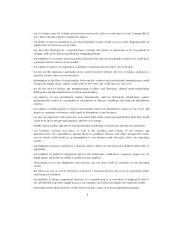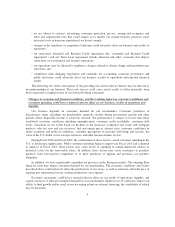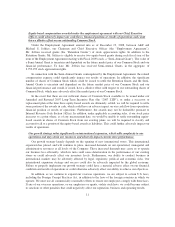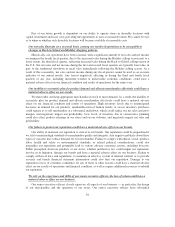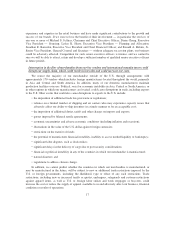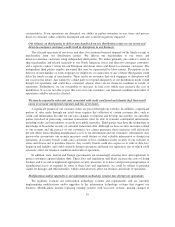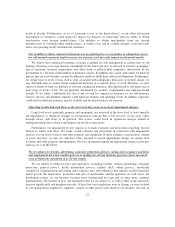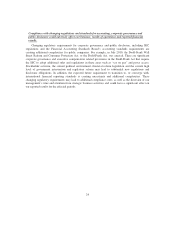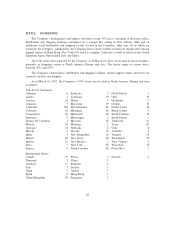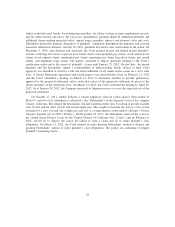Abercrombie & Fitch 2011 Annual Report Download - page 21
Download and view the complete annual report
Please find page 21 of the 2011 Abercrombie & Fitch annual report below. You can navigate through the pages in the report by either clicking on the pages listed below, or by using the keyword search tool below to find specific information within the annual report.
We do not own or operate any manufacturing facilities and, therefore, depend upon independent third
parties for the manufacture of all our merchandise.
We do not own or operate any manufacturing facilities. As a result, the continued success of our
operations is tied to our timely receipt of quality merchandise from third-party manufacturers. Our products
are manufactured to our specifications primarily by foreign manufacturers. We cannot control all of the
various factors, which include inclement weather, natural disasters, political and financial instability,
strikes, health concerns regarding infectious diseases in countries in which our merchandise is produced,
and acts of terrorism, that might affect a manufacturer’s ability to ship orders of our merchandise in a
timely manner or to meet our quality standards. A manufacturer’s inability to ship orders in a timely
manner or meet our quality standards could cause delays in responding to consumer demands and
negatively affect consumer confidence in the quality and value of our brands or negatively impact our
competitive position, any of which could have a material adverse effect on our financial condition and
results of operations. We are also susceptible to increases in sourcing costs from our manufacturers which
we may not be able to pass on to our customers and could adversely affect our financial condition or results
of operations.
Additionally, while we utilize third-party compliance auditors to visit and monitor the operations of
our manufacturers, we do not have control of the independent manufacturers or their labor practices. As a
result, the risk remains that one or more of our manufacturers will not adhere to our global compliance
standards and violate labor laws or other laws, including consumer and product safety laws.
Non-governmental organizations might attempt to create an unfavorable impression of our sourcing
practices or the practices of some of our vendors or manufacturers that could harm our image. If either of
these events occur, we could lose customer goodwill and favorable brand recognition.
Our reliance on two distribution centers domestically and two third-party distribution centers
internationally makes us susceptible to disruptions or adverse conditions affecting our distribution
centers.
Our two distribution centers located in New Albany, Ohio, manage the receipt, storage, sorting,
packing and distribution of merchandise to our North American stores and to our North American and
Asian direct-to-consumer customers. We also use a third-party distribution center in the Netherlands to
manage the receipt, storage, sorting, packing and distribution of merchandise delivered to our stores and
direct-to-consumer customers in Europe and a third-party distribution center in Hong Kong to manage
receipt, storage, sorting, packing and distribution of merchandise delivered to our stores in Asia. As a
result, our operations are susceptible to local and regional factors, such as system failures, accidents,
economic and weather conditions, natural disasters, demographic and population changes, as well as other
unforeseen events and circumstances. If our distribution operations were disrupted, our ability to replace
inventory in our stores and process direct-to-consumer orders could be interrupted and sales could be
negatively impacted.
We are in the process of consolidating our two distribution centers in New Albany into one
distribution center, with an expected completion date at the end of Fiscal 2012. This consolidation requires
management’s focus and attention, as well as significant capital investments. We believe this consolidation
will result in improved operational efficiencies and that one distribution center in New Albany is adequate.
However, if we are unable to operate effectively with one distribution center, our distribution operations
could be disrupted. Furthermore, consolidation into one distribution center increases our susceptibility to
risks associated with system failures, accidents, weather conditions, natural disasters, and other unforeseen
18


